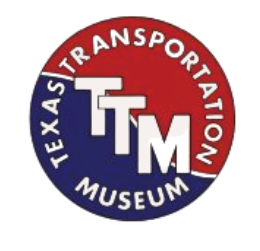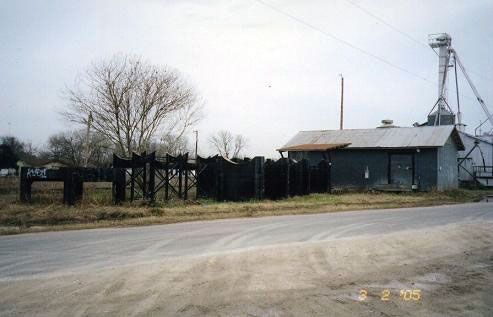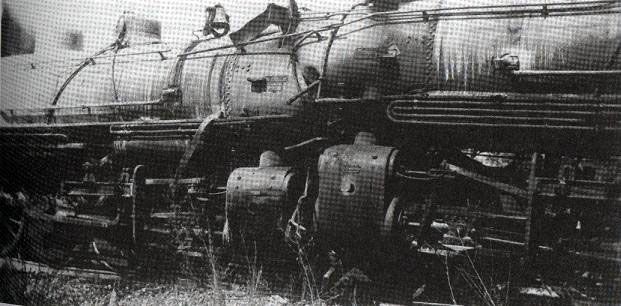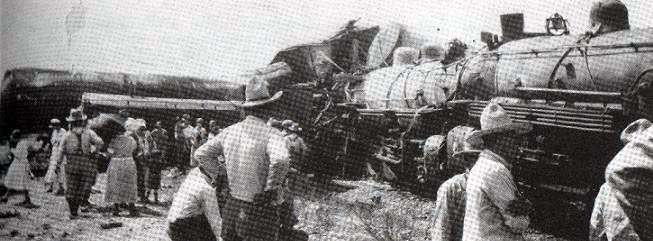The Railroad in Macdona, LaCoste, and Pearson
The museum is indebted to the LaCoste Garden Club. It's members wrote and published ECHOES OF THE PAST in 1996. It features histories and pictures of LaCoste and surrounding towns. The authors created a treasure trove of local history which would have otherwise been lost or overlooked. To get a copy, contact:
Ellen Jonas Loessberg
P.O. BOX 805
LaCoste TX 78039
(830) 985-3989
We are also grateful to Robert Zeinert, the postmaster in Macdona, for several pictures and some additional reminiscences, not to mention helping to find a copy of the above mentioned book, to which he was a significant contributor.
Macdona, Texas
Macdona is at the south western limit of Bexar County, approximately eighteen miles out from downtown San Antonio. After the Southern Pacific bought the Galveston Harrisburg & San Antonio, the railroad began to build westward from the city in 1881. Macdona is named for the owner of the land. The railroad paid him $172.27 on January 14, 1882 for right of way across the area. A spur line was also put in. Businesses, like a cotton gin, were established. the earliest lots for housing were sold in July of 1886. A post office was opened the same year. A school had been established by 1891. The Lange Brothers cotton gin was doing a roaring trade by 1900, with over 900 bales shipped in October. Dairies in the area had the latest cream separator equipment. In 1905, a depot and a hotel were built, complimenting the general store and three saloons already operating. The first agent was Carl Watts. The town became a tourist destination for the Sunday afternoon crowd. For 50 cents you could get out of the city and into some nice countryside near the Medina River. A shooting club was opened in 1908.
In 1909 the Artesian Belt railroad built a line to Macdona from a place called Kirk, five miles to the south. The line stretched through Poteet and Jourdanton to Christine. This created more activity on the area. Another general store, owned by the Zeinert family, opened in 1910. They also restored a nearby cotton gin close to the depot. Cattle pens were also close by. In 1912, Medina Lake was completed and with it irrigation for the surrounding area. In 1920, the new owner of the Artesian Belt abandoned the tracks between Macdona and Kirk, where there was a connection to the International & Great Northern line. Its route was eventually paved and is now known as Kearney Drive. Despite this loss, the town, which never incorporated, continued to do well. The local garage, also a Zeinert business, sold Overland cars for $1,025.00. Walter Koehler sold Fords. Macdona lost its depot in the mid 1930s. It was purchased by a local farmer ad served as a barn until it burned down sometime in the late 1940s. For decades the Macdona Dance Hall was the center of social activity. Many big name stars played there, including Bob Wills and the Texas Playboys and Tex Ritter. It closed in 1952 and became an auction hall. It finally burned down in 1968. Macdona began to fade in the 1940s. With the creation of Loop 1604, the town and the adjacent unincorporated town of Atascosa have seen some renewed growth. The railroad still goes through. Sadly, the area was forced into the spotlight in 2004 when a train accident on a nearby siding sent clouds of chlorine gas into nearby houses. Three people died and fifty more were injured.
LaCoste, Texas
LaCoste is another seven miles along the line, just inside Medina County. It is about five miles south of Castroville, which was then the county seat. A stage coach service was begun to the new depot that cost 50 cents. The railroad avoided Castroville for two reasons. One, the topography is very hilly around the town and would have caused serious problems for the tracks, which needed to be kept as level and straight as possible. Routing the line to avoid major hills is always preferable to any railroad. Two, Castroville declined to offer a bonus to cover the probably inordinately high expenses of the difficult construction. the site that is now LaCoste was not the first choice for the new town the railroad wanted to create. It grew to prominence over a nearby community a mile to the east called Idlewild. Idlewild was named by its owner who came from New York state. (JFK Airport was once known as Idlewild Airport.) The initial water tanks for the steam locomotives were built in Idlewild but the people there could not provide enough land for a town to the railroad. Howard Russell sold the G.H. & S.A. 175 acres nearby and LaCoste was formed there. The town was originally called Fernando but the name was changed to LaCoste in 1898 for a prominent local businessman who invested in the area. Occupation of this part of Texas can be traced back hundreds and possibly thousands of years. Buffalo once were plentiful, due to the Medina River, as were wild ponies.
With its new depot, LaCoste began to grow. In 1892, the agent was E.F. Howard. Mail for the whole area, including Castroville was handled here. General stores opened, as did hotels, restaurants and saloons. Around 1895, a successful well was dug in LaCoste that supplied the whole town as well as the ever thirsty locomotives. The railroad continued to be the water suppliers here until 1955, around the time that diesels had completely replaced steam. A new water district was then formed. In March of 1903, a terrible accident involving two passenger trains happened right outside the depot. At almost ten o'clock at night, a local passenger train, running two hours late, made an unscheduled stop in LaCoste. The "Sunset Limited," also way behind schedule, which did not stop here, came right through town and smashed into the rear of the stationary train. The wooden Pullmans at the rear of the first train simply shattered into splinters. The ensuing fire engulfed the depot. Three passengers, attendants of 'General Trevino of Mexico, passengers on the first train were killed. Eight others were injured. The local paper reported that it took only three hours to clear the tracks for more traffic.
By 1914 the population of LaCoste was around 400. Two years earlier, a larger hotel was built by Emil Schmidt. It still stands today. Plentiful irrigation water was provided by the newly built Medina Lake in 1912, boosting agriculture and allowing for a switch from dry farming to more profitable crops. In August 1915, LaCoste received 2 cars of lumber, 1 of cement, 1 of livestock, 1 of household goods, 4 of beer and 4 of ice. It shipped out 36 cars of corn, 3 of hay and 3 of empty kegs. Spillage from the water pumps as they topped up locomotives led to considerable flooding around the area of the water tank. The railroad was obliged to create deep water channels to keep the road crossings dry. The area is still very soggy today. When I worked as a railroad crew "limo" driver in 2003, I brought a crew to a train stationary on the main line, for reasons best known to the Union Pacific, at around 4:00 AM one fall morning. We found the train easily enough but the grass around it on both sides looked like a rice paddy. Crews tend to travel with heavy carry all baggage and always want the vans to get as close as possible to the lead locomotive. In this instance I had to decline. So they had to walk to the train quite some distance from the road crossing. I waited with their bags and they brought the train to me to pick up their gear. You don't seem to see it as much anymore but it used to be when flooding got really bad, they would park locomotives on top of bridges to stop them floating away. Maybe drainage is better now or the locomotives are less expendable..
For a while LaCoste enjoyed a certain reputation for, shall we say, less restrictive forms of social activity, as befits a brand new town, a railroad town at that, on the frontier. The saloons provided a place of respite for the hard working men and women of the area. This era lasted until around 1910 when a large Catholic church was erected and decency and order and all the other trappings of polite civilization took over. Even so, prohibition was never very popular in Texas, and, somehow, the saloons here, as elsewhere, managed to get by. LaCoste, which has a population of around 1,200, is now significantly off the beaten track and it retains a great deal of its turn of the 20th century charm in a 21st century world. As elsewhere, most agricultural produce is moved by trucks. Some railroad sidings are still in place today and they see occasional use. Passenger travel lasted here a little longer than most but by 1968, Southern Pacific was closing local depots as fast as it could and LaCoste was no exception. It was purchased by Herbert Jonas, who used its timbers for a house in Macdona. His daughter, Ellen, is one of the authors of the book, "Echoes of the Past," and has been very supportive of this project. She recalls that the wood from the depot was so hard that it was very difficult to so much as drive a nail into it.
Pearson, Texas
Pearson was a very small community a few miles west of LaCoste. A larger town was platted but no lots were eve sold there. It did have a school and a general store. Another small community called Noonan's Switch was created by the railroad a few miles further on. There was a siding there so trains could pass each other on the otherwise single track main line. A large cistern was installed to supply water to the trains and also the small store and the section house and the cattle pens which were established here. A head on collision happened at Pearson on 10/3/1924 at 9:00 AM. Two members of the crew of the east bound freight, engineer Almar Puckett and conductor Tom Johnson, both from San Antonio, were killed. The fireman survived with just a few scratches. The crew of the westbound train, also a freight, managed to jump off before the accident. Both locomotives and about ten cars were destroyed. The damage was estimated at $44,150 for the equipment, $2,000.00 for the freight, $150.00 for damage to the tracks and $1,000.00 for clearing the wreckage. Children in the school here and at LaCoste heard the explosion and the site of the accident drew in many as visitors over the next few days. An inquiry found three causes for the accident. The operator at Hondo failed to enter an order for the trains to pass at Dunlay. The dispatcher at Del Rio neglected to check the order book and the crew of the west bound train passing an automatic signal that indicated the track was occupied. In other words there had been three opportunities to avert the disaster and all were ignored.
Both Pearson and Noonan's Switch have disappeared now. Fortunately, the members of the LaCoste Garden Club have created a really great archive that saves the memories and pictures of the people who lived there and remember them with great affection. Anyone interested in how communities west of San Antonio were created should obtain a copy of Echoes Of The Past. It is well written and put together and gives great insight into how people lived in the early part of the 20th century when this area was settled for the first time, with the help of the railroad.
Frank Crothers at the San Antonio bicycle race track.
Transportation Museum
CONTACT US TODAY
Phone:
210-490-3554 (Only on Weekends)
Email:
info@txtm.org
Physical Address
11731 Wetmore Rd.
San Antonio TX 78247
Please Contact Us for Our Mailing Address
All Rights Reserved | Texas Transportation Museum





























